On May 17, LGBTQ+ people worldwide will mark the International Day Against Homophobia, Biphobia, Interphobia and Transphobia (IDAHOBIT) for the 15th time.
It is a global annual event that draws the attention of decision makers, the media and the public to the alarming situation faced by people with diverse sexual orientations, gender identities or expressions and sex characteristics. But it also celebrates all the diversity and gains won to achieve better lives for LGBTQ+ people.
May 17 was specifically chosen to commemorate the World Health Organization’s decision in 1990 to declassify homosexuality as a mental disorder. The decision came twenty years after the first ever Gay Pride Parade was organized in New York City, that followed the Stonewall riots of 1969, widely known as the catalyst for the modern LGBTQ+ rights movement.
The concept — first known as IDAHO — was developed in 2004. In 2005 many individuals and large international organizations such as the International Lesbian and Gay Association (ILGA) and the International Gay and Lesbian Human Rights Commission (IGLHRC) demanded public support for the day in a yearlong campaign.
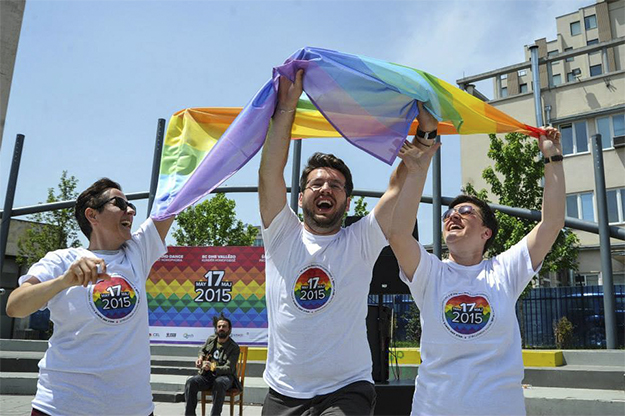
Protesting and celebrating are at the heart of the IDAHOBIT movement, IDAHOT 2015. Photo courtesy of CEL.
Today it is commemorated in over 130 countries, including in 37 where same-sex acts are illegal.
The ‘T’ for transphobia was added explicitly to the title of the name in 2009, and recognizes the different experiences between those who are attracted to the same sex, and people who are transgender or gender diverse. In 2015 the letters ‘B’ and ‘I’ for Biphobia and Interphobia were added. Local organizations can choose to add different letters as they see fit, the name is not trademarked.
“This day was always used to draw the attention of governmental and public institutions about their responsibility to enforce Kosovo’s legislation, in order for them to promote and respect LGBTQ+ people and guarantee these rights, as a measure toward equality,” says Arbër Nuhiu, executive director at the Prishtina-based LGBTQ+ organization, the Center for Social Group Development (CSGD).
Through the words of LGBTQ+ people, activists and supporters, K 2.0 brings you an insight into how IDAHOBIT has evolved over the years.
In the beginning …
In 2007, when local LGBTQ+ activism was first starting, IDAHOT was marked for the first time in Kosovo. CSGD’s Nuhiu recalls how activists placed banners and placards around Prishtina and organized a public discussion that was held at the Oda Theater. The discussion was broadcast by Rrokum TV, Nuhiu says that no other media was interested.
“The good thing about the day was that for the first time a public campaign was done,” he says. “We had many volunteers, and I didn’t believe myself that so many would be interested. Around 300 posters were plastered throughout the city and all of this was done under one hour. Apart from the CSGD staff we had 20 volunteers.”
A year later, on the same day, Nuhiu says that activists organized a small campaign, covered mainly by individual contributions, as they lacked financial support.
“Stickers were placed around the city with different messages, written by LGBTQ+ people and our people at CSGD.”
Nuhiu said that on IDAHOBIT in 2009 the organization he leads sent informative letters to all institutions that have a mandate to promote and protect human rights — Ministries, municipalities, Kosovo Police, Prosecutor’s office and Judicial Councils — about legislative provisions that guarantee LGBTQ+ rights.
That same year, CSGD sent a request to the Office of Good Governance (OGG), a monitoring and advisory body within the Prime Minister’s Office on Human Rights to officially recognize and support IDAHOBIT.
“Of course we didn’t receive any official answer to our request. But, quietly, the Government of Kosovo, through the OGG, has recognized it as an international day since 2009,” Nuhiu said. “But apart from ‘moral support,’ nothing was done on this day, until 2012 when the OGG organized a conference for IDAHOBIT. For the first three years the OGG said that the government doesn’t have the funds to organize anything on May 17.”
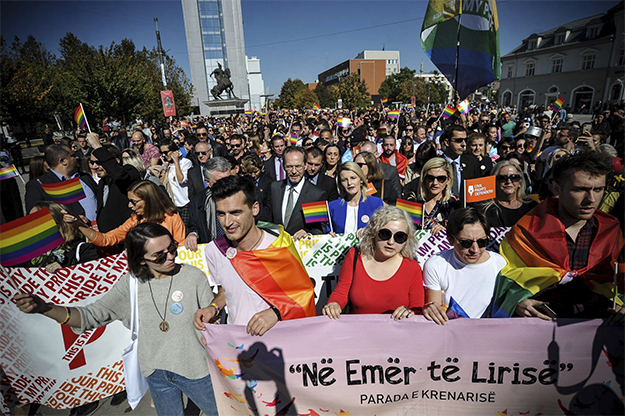
IDAHOBIT opened the way for the Pride Parades. 2018. Photo: Atdhe Mulla/ K2.0.
Because of the lack of financial support, LGBTQ+ NGOs had to give up on plans to mark IDAHOBIT with symbolic actions in 2010 and 2011.
“We just sent statements to the media that were never published,” Nuhiu says. “The media at that time was not very open to discussing these issues, apart from particular cases.”
The lack of media scrutiny changed one night in December 2012, when an event on sex and sexuality organized by Kosovo 2.0 was attacked by people presumed to be religious radicals and football hooligans. Another attack, this time inside the LGBTQ+ organization, Libertas, occurred a few days later. Many people who were in both places were physically assaulted.
Claiming the space
For three years (2014-2016), on IDAHOBIT, LGBTQ+ people, activists, and allies claimed public space, flying the rainbow flag in symbolic marches through Prishtina’s main squares.The marches were organized by the LGBTQ+ organizations, Equality and Liberty (CEL), Center for Social Group Development (CSGD) and the Center for Social Emancipation (QESh). Usually citizens would gather in Skanderbeg Square, where activists would go from group to group offering rainbow badges, t-shirts and placards to hold aloft while they walked.
The organizers would make sure that by the end of the event they addressed all LGBTQ+ people still in the closet who cannot be themselves because they are surrounded by homophobia and transphobia in Kosovo.
Lend Mustafa, one of the most prominent LGBTQ+ activists in Kosovo, and the first transgender person to come out publicly, says that the marches triggered the visibility of LGBTQ people, but also activism in the public discussion.
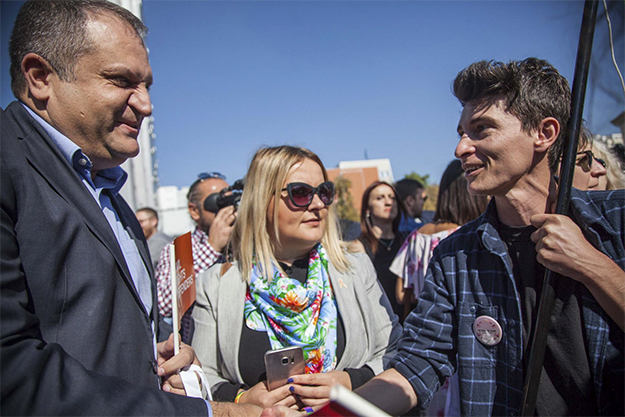
Politicians began coming to the IDAHOT March in 2014. 2018. Photo: Majlinda Hoxha/ K2.0.
“Until then, our community was working, but we were in the shadows, in the eyes of society. By giving powerful and direct messages about the rights of our community, and expressing our challenges publicly, we showed another portrait, another story,” he says. “Marches were one of the first actions that broke the walls where we were hidden.”
He reflects how for him and many other LGBTQ+ people the thought of “being the only person in the world,” was terrifying.
“The fear is that you are alone in your journey. By being visible, all of us give hope to LGBTQ+ people and make it known that they are not alone. I know because I was in that situation myself.”
Sarah Maliqi, a program officer at Civil Rights Defenders (CRD), one of the greatest supporters of LGBTQ+ people in Kosovo — as an individual and with the organization she works at — has been part of every single activity organized on IDAHOBIT.
“I remember the first IDAHOBIT march in 2014 — though it seems like a dream now — there weren’t many people from the community. Those that participated, wore masks, costumes and so on. Today, the majority of them participate openly,” she says. “We cannot talk about equal rights, if we don’t have a powerful and vibrant community.”
She said that marches and other activities on IDAHOBIT played an important role in discussing the responsibility of state institutions, and that IDAHOBIT round tables served to include diverse mechanisms that worked to advance the rights of LGBTQ+ people and discuss their position.
Sibel Halimi, sociologist, notes that despite all the efforts that NGOs made, the first IDAHOBIT march in 2014, was crucial in transferring LGBTQ+ rights from the private to the public sphere.
“The use of a march as a political or even artistic instrument, made issues concerning LGBTQ+ people not only private matters,” she said. “It didn’t improve the situation of the LGBTQ+ community in Kosovo, but the enthusiasm, the will of LGBTQ+ people and activists gave a different sort of emotion and in one way the talk about sexuality and the body wasn’t a private issue anymore.”
The IDAHOBIT march in 2014 — for the first time since Kosovo’s independence in 2008 — had public support from political leaders, with a few of them participating in the march, together with other EU and international representatives.
“The participation of politicians legitimized the sexual diversity of LGBTQ+ persons, because up till then the discussion happened only behind closed doors, on the legislative level, in the form of policies and regulations,” adds Halimi.
Demanding to belong
A form of public support that Kosovar governments have shown since 2014 on IDAHOBIT is the lighting of the government building with the rainbow colors.
But this year, after an initial confirmation, government representatives wrote to activists asking them to think of something else instead. A huge backlash from activists and the LGBTQ+ community followed.
Activists said that they insisted on lighting up the government building, especially because there was no possibility to hold their normal activities due to the Covid-19 pandemic. According to them this would send a message of solidarity to LGBTQ+ people from Kosovar institutions. According to activists and researchers, LGBTQ+ people are experiencing increased hostilities in lockdown.
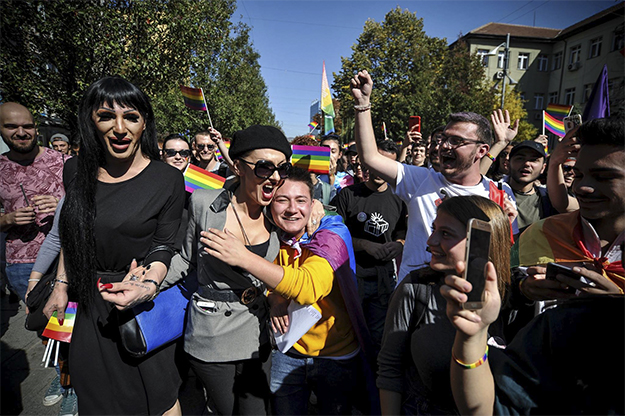
People and supporters would hide themselves at first. Now they can be open. 2018. Photo: Atdhe Mulla/ K2.0.
After public pressure the government has decided to continue with the traditional lighting this year. But it also confirmed the perspective that institutions — even when led by a party that promotes social justice — still do not have a strong stance on support for LGBTQ+ rights.
Sibel Halimi said that this lack of enthusiasm from the Vetëvendosje (VV) party to explicitly support LGBTQ+ people, is shown in the form of a lack of direct, bold statement of support; or in the form of not organizing or initiating public debates with the community. However, apart from the odd politician, no government until today has strongly supported LGBTQ+ rights. Once, the former prime minister, Ramush Haradinaj even used a homophobic slur to describe his opponents.
“The closer a political party is toward elections, the bigger the hesitation it has to give support because they do not want to be included in a direct debate that deals with LGBTQ+ rights. The [governments] are aware that [LGBTQ+ people] are stigmatized and discriminated against and so they fail to create an emancipatory project for Kosovar society,” she said.
Halimi said that the fight for LGBTQ+ rights still has a long way to go and the discussion has to become an integral part of the agents of socialization, such as family and school.
“An effort needs to be done to include the issue of sexuality and the body into textbooks, formal and informal discussions of curricula in education. Education is one of the key instruments that prepares young people about LGBTQ+ people,” she says. “On the other hand the visibility and campaigns are necessary, the usage of art to raise social awareness.”
Halimi described how a massive campaign affected all the dimensions of the city when New York legalized same sex marriage, with huge portraits of gay couples hugging placed in public areas such as the inside of subway stations.
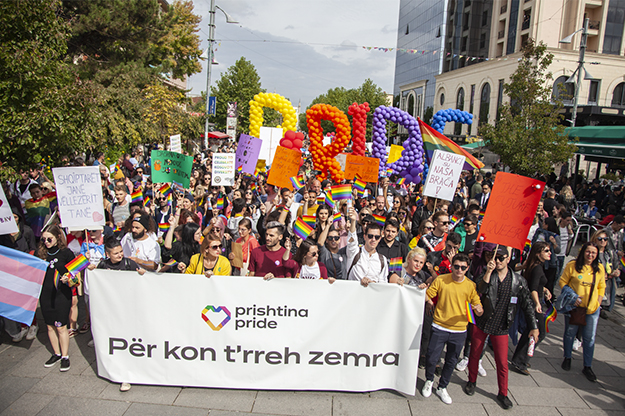
LGBTQ+ people are still demanding their right to live as they want. 2019. Photo: Majlinda Hoxha / K2.0.
Arbër Selmani is a journalist and activist who has covered LGBTQ+ people extensively for more than a decade. He says that his coverage and observations clearly suggest that survival for nonwhite, non-hetero people and women is very difficult in Kosovo. According to him, IDAHOBIT represents a chance for the community to stand out, to be part of the discourse and of the public narrative.
“Often this discussion deviates and then hurts,” he said. “IDAHOBIT is another opportunity for a constructive debate, to reflect on where we are as a society, why are we not letting people live their lives the way they want? Why do we not accept what is different from us? Why should each of us be in a box that this society has built?”
Maliqi from the CRD adds that taking concrete measures and real commitment from Kosovo’s institutions in advancing the rights of the LGBTQ+ community, as well as eradicating the institutionalized homophobia in central, local governments, police and judicial institutions, is fundamental to LGBTQ+ rights. She says that IDAHOBIT raises exactly these questions, sending the message that “LGBTQ+ people need to have similar opportunities as others: A free and dignified life to decide who they want to live with, love, where they want to get schooling and work.”
According to Maliqi the legacy of IDAHOBIT in Kosovo paved the way to the Pride Parades consisting of more than 800 participants and other important victories such as the court case that legalized name and sex marker changes in identification documents.
In 2017 Kosovo held its first Pride Parade. It was a lively and joyous event in Prishtina’s center. In contrast to the previous IDAHOBIT marches that due to security precautions were never announced before May 17, Pride today is announced publicly weeks earlier.
“We can say that the IDAHOBIT marches were used to measure the situation in Kosovo to organize Pride, but it wasn’t planned initially like that. Pride parade and Pride week are a result of a revolutionary moment, when activists were tired of all the refusals, neglect, and challenges to organize the marches,” Lend Mustafa said. “However, the march against Homophobia, Biophobia and Transphobia was a forum we used to ask for more, to demand what belongs to us.”
Feature image: Photo courtesy of CEL.
This article is part of the project “Advancing the Position of LGBTI Persons in Society”, funded by the Embassy of the Kingdom of the Netherlands in Kosovo, and implemented by the Centre for Equality and Liberty CEL.
Opinions expressed herein do not necessarily reflect the views of the Embassy of the Kingdom of the Netherlands in Kosovo.

